Chamomile is a marvelous medicinal herb with beautiful blooms. But let’s be honest: it can be a bit boisterous in the garden.
It’s one of those plants that you start growing, only to find a few years later that it has reseeded, and volunteers have started popping up all over the place.
Or maybe you don’t have the space to dedicate to an in-ground plot for your favorite herbs, but you long for the fresh taste of homegrown chamomile tea.
The solution? Containers.
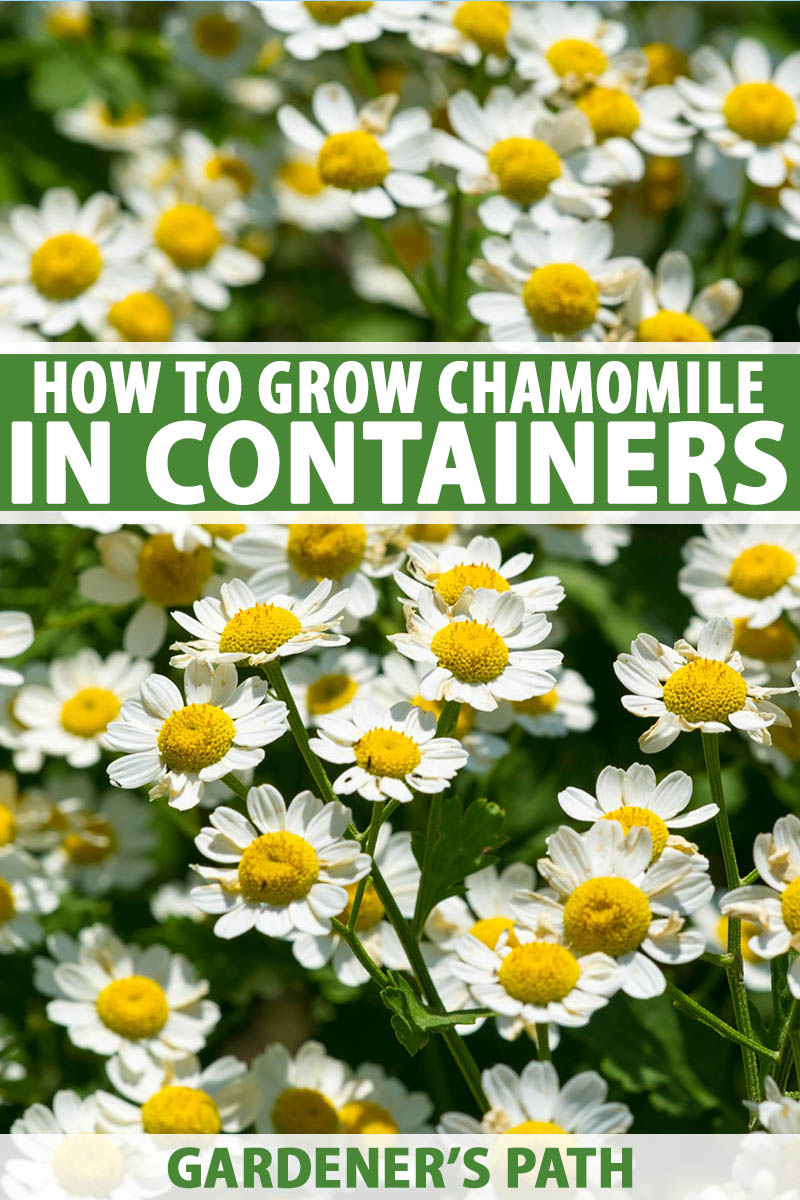
We link to vendors to help you find relevant products. If you buy from one of our links, we may earn a commission.
Planting chamomile in a pot keeps things under control. You can still enjoy those pretty little white flowers, even if you only have a tiny spot in the corner of your apartment balcony.
There are two types of chamomile: Roman, Chamaemelum nobile, and German, Matricaria recutita.
Both are suitable for container growing, but German chamomile can get large, so you’ll need a heftier pot to grow this one. I’ll provide more differences between the two species below.
Here’s what we’ll cover:
What You’ll Learn
Why Grow Chamomile in a Container?
In general, growing any herb in a container can make it easier to use.
When it’s located close to your kitchen, as part of your patio or deck decor, it’s that much easier to bring in a harvest when you need it.
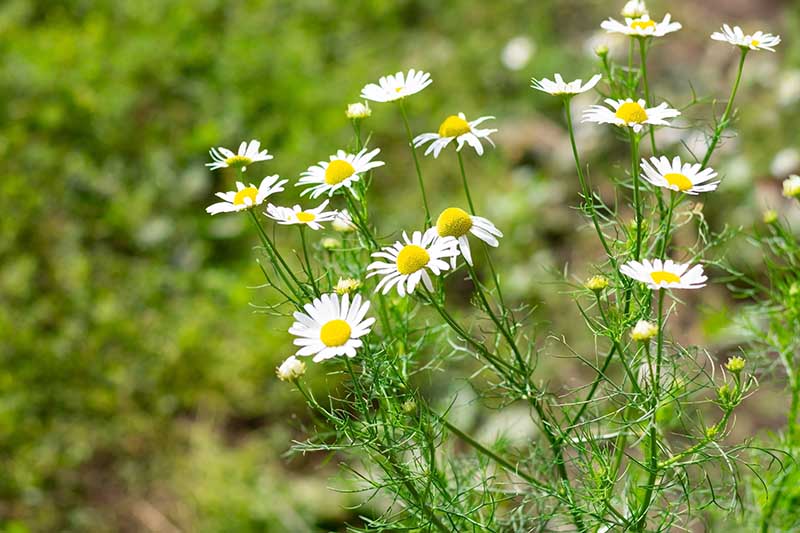
Bringing the color and scent closer to home, immediately outside your office window, for example, means you can more readily enjoy the flowers as they bloom.
Growing in pots also lets you keep a good eye on your plants in terms of care – you’re more likely to notice an invasion of pests or a pot in need of water when it’s right outside your door or just beyond your window.
And when garden space is at a premium, it’s often much easier to find a new place to plop a pot than it is to eke out a few more square feet of raised bed or in-ground row.
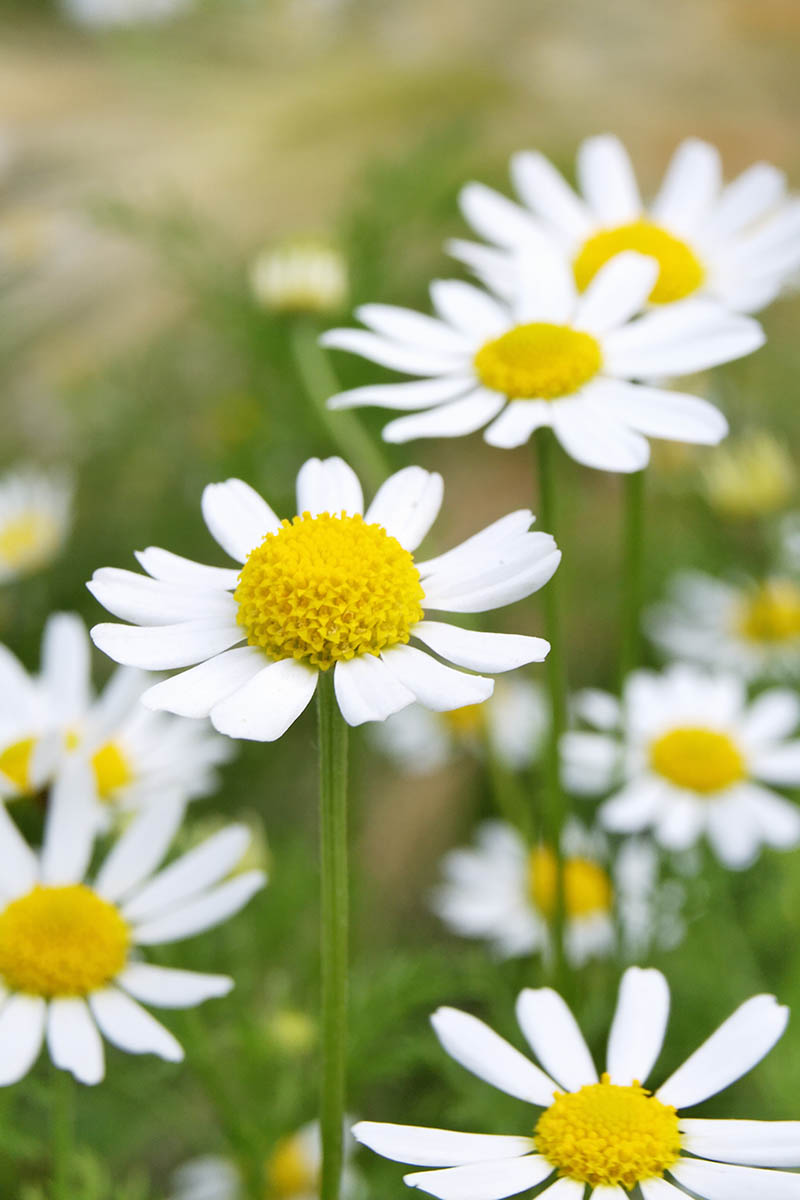
In addition to all of these factors, chamomile in particular works well in containers because it has a tendency to self-seed all over the garden.
A few years after you put your first chamomile plant in the ground, you may find volunteers popping up in places where you didn’t want or expect them.
I spent one summer pulling this pretty herb out of my zucchini and mint beds – though I admit didn’t have the heart to pull all of it. Mint also has a tendency to spread, but at least I had an abundance of herbal tea that year!
In a container, the prolific tendencies are more easily kept in check. It’s also a plant that can handle a little dryness, so it’s practically tailor-made to live in a pot. Container-grown plants tend to dry out more quickly than plants grown in-ground in the garden.
As if that wasn’t enough, it’s not just ideal for planting outdoors. You can also grow chamomile year-round indoors! We cover that in more detail in a separate guide but I’ll touch on it here as well.
The Roman type tends to produce fewer flowers than the German variety, so if you’re hoping for an abundant tea harvest, go for German chamomile.
Matricaria recutita, German Variety
You can find packets of M. recutita seeds available at Eden Brothers and in packets of 100 from Earthbeat Seeds.
Roman C. nobile is also shorter, so I like to plant it as a low-growing accent in my potted garden, along with a taller plant in the center, such as lemongrass or ornamental kale.
Chamaemelum nobile, Roman Variety
Because of its size, Roman isn’t ideal for growing indoors.
You can find C. nobile seeds in packets of various sizes available at Eden Brothers.
Choosing the Best Container
When it comes to growing chamomile, just about any container you can find will do, so long as it has good drainage and is large enough.
I’ve reused paint cans, an old chicken feeder, an antique sink, and drawers from a dresser that had broken.

Whatever you use, make sure it’s sturdy enough to not get knocked over easily, and that it doesn’t contain any potentially harmful chemicals if you plan to consume your harvest.
For instance, anything covered in paint from before the late 1970s might contain lead.
Of course, you can always go for the more traditional terra cotta, clay, or plastic potting containers.
Whatever you use, make sure the pot has at least one quarter-inch drainage hole spaced every two to three inches on the bottom. Chamomile can handle a bit of drought, but wet feet will kill it.
Keep in mind that if you use something like cement or terra cotta and you plan to move the container in and out of doors, it may crack due to the changes in temperature. Resin or plastic may be a better choice.
When it comes to size, you shouldn’t crowd your chamomile. It has shallow roots, but requires space to spread out.
It’s tempting to look at those pretty pictures on Pinterest that show compact, overflowing herb containers, but many of those plants don’t have enough space to spread and grow.
Your German chamomile plant needs a container that’s at least 12 inches wide and eight inches deep.
Keep in mind the plant grows up to 24 inches tall at maturity, so the pot should be heavy enough to support the plant and prevent it from tipping over.
If you plan to grow it with a companion plant like basil, select a container that is at least 18 inches wide.
Roman chamomile requires a container that’s 18 to 24 inches wide so that it can spread out, and about 8-inches deep.
Picking the Right Site
Chamomile attracts all kinds of beneficial insects like bees, butterflies, hoverflies, and parasitic wasps, so you might consider keeping your containers near your herb or veggie garden, or other potted edible plants that require pollination.

It also likes to stay cool, and containers tend to get warmer during hot weather than plants growing in the ground.
Put your pots in an area where they will be partially shaded during the heat of the day if you live in a warm climate, or plan to move them as needed. Those in cooler climates can grow in a full sun location.
Try to avoid placing potted chamomile in a location where the heat will be amplified, such as next to a brick wall.
If temperatures in your area climb above 100°F, move your container to a shadier, cooler spot during the hottest days.
Once cold weather arrives, move the plants indoors if you want to keep the harvest going. Keep in mind that the German variety is an annual, while Roman is a perennial.
Neither plant can withstand more than a brief, light frost.
Preparing the Pot
Before you use any container, it’s a good idea to be sure that it’s sterile to avoid diseases like damping off. You should even do this with new ones purchased from the store.
Wipe down the interior with a mixture of bleach and water, in the ratio of one part bleach to ten parts water.
Select a good quality potting soil mix that contains peat moss, vermiculite, or coconut coir, which helps to retain water and improve drainage.
You could also add some perlite, which helps to increase aeration and drainage.
Then, fill the container to an inch below the rim.
Avoid using garden soil, as you want to make sure it is sterile and free from weed seeds or soil-borne disease.
How to Grow
Chamomile can be planted by seed, transplants, or divisions. You can read more about the various options in detail in our guide to growing chamomile.
Below you’ll find a brief synopsis of these methods, with additional details catered specifically to container growing.
From Seed
You can start seeds indoors six to eight weeks before the last frost to give yourself a longer growing season.
This is especially useful if you live in an area with sweltering summers, since chamomile stops growing when temperatures approach 100°F.
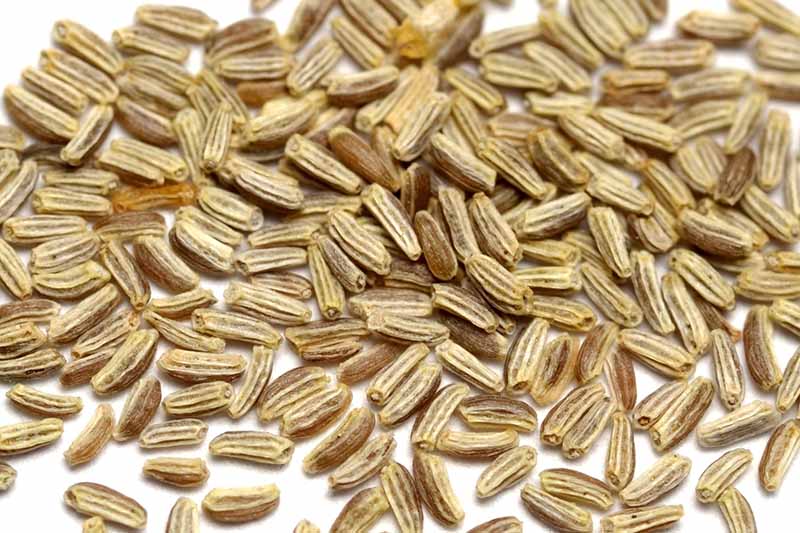
You can either sow your seeds in seed cells or trays for transplant later, or direct seed into their permanent container home.
Sprinkle the seeds on top of the soil. Optionally, you can lightly cover them with sand.
The seeds need light to germinate, so don’t cover them too much. Keep the soil evenly moist and in two weeks you should see the seedlings emerge.
Place them in a window where they’ll get at least six hours of light a day, or provide artificial lighting.
Thin the seedlings when they’ve grown to an inch or two in height. You only want one seedling per cell, or one plant per 12-inch container.
Once plants are four to six inches tall, you can transplant them – if growing in seed cells – following the instructions given below.
After all risk of frost has passed, it’s time to harden off your plants, ready for life outdoors.
To do this, place the container in a sheltered, sunny location for a few hours per day, gradually increasing over the course of a week.
Alternatively, you can sow seeds in containers outdoors after all risk of frost has passed.
From Seedlings or Transplants
You can buy chamomile seedlings at most nurseries in spring.
Before transplanting to your permanent container, you’ll need to harden them off as described above, after all risk of frost has passed.

To transplant seedlings, dig a hole in your prepared container twice as wide and the same depth as the transplant pot.
Place the seedling inside and backfill the hole with soil, and water in well.
By Division
If you, or a neighbor, has Roman chamomile growing in the garden, you can divide it. The best time to do this is in early spring before the plant has started putting out new growth.
To do this, dig up a clump about six inches wide, and six inches deep and separate the rhizomatous roots into two to three sections, each with at least one stem.
Replant into your container, covering the root and half to one inch of stem. Water in well, and keep the soil evenly moist.
Learn more about this method in our guide to dividing perennials.
Container Care and Harvest
Chamomile has shallow roots, and when it’s young, it can be traumatized by a lack of water. Once it’s gotten its legs, a well-established plant can handle a little drought.
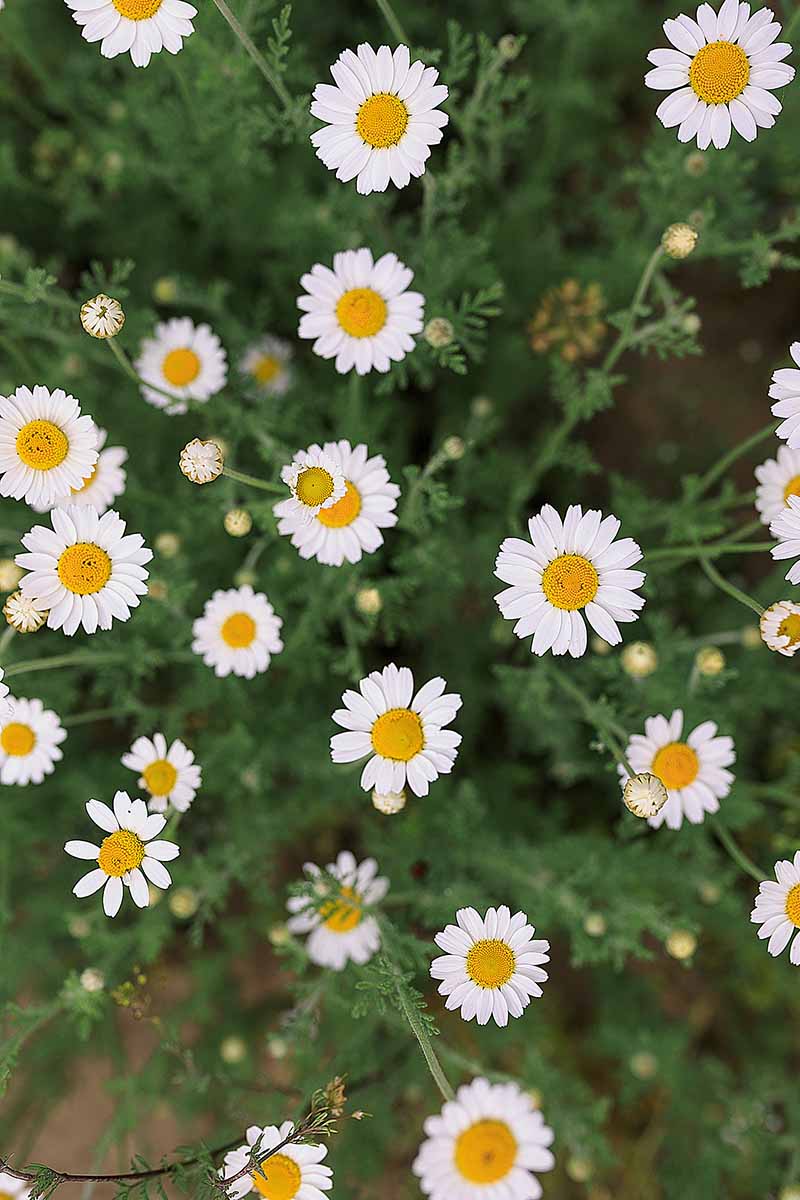
Plants need about an inch of water in total each week. That means if you get an inch of rain a week, you don’t need to get the hose out. Put a rain gauge in your garden space to save money on watering costs.
Your finger can be a pretty effective tool as well. Just stick a digit into the soil, and check for moisture. Water when the top half-inch of the soil feels dry.
Chamomile growing in soil that is low in nutrients becomes top-heavy and weak.
Fertilize by watering with fish emulsion once a month at half the manufacturer’s recommended amount, after the plants have reached their mature height. Use deodorized fish emulsion if you’re growing your plants indoors.
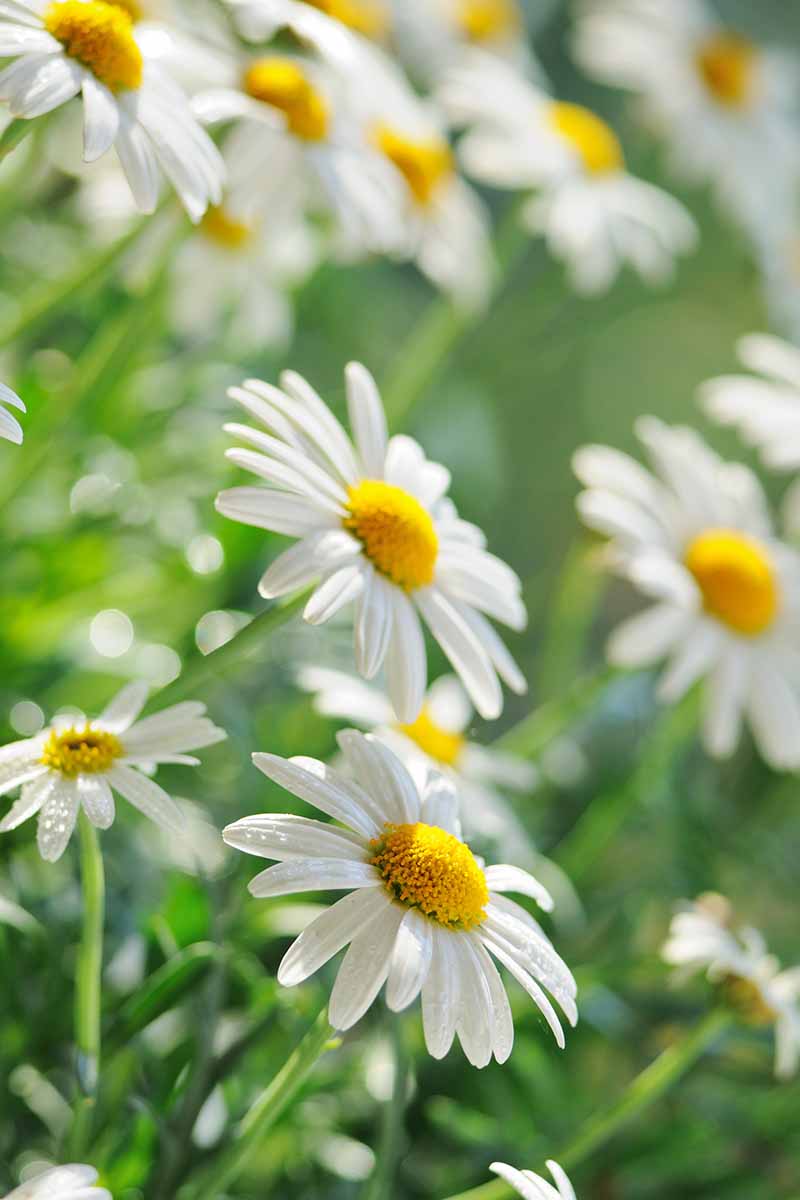
While chamomile can happily survive without fertilizer when it’s growing in the garden, it needs a little extra love in a container, since it doesn’t have as much access to nutrition.
The plant can’t send out roots to find more nutrition as it is constrained by the container. Watering also flushes out some of the nutrients from the soil, so you’ll need to replace them.
You should harvest chamomile when the flowers are freshly opened. Don’t wait until they’ve been open too long, and try not to pick them before they’ve opened fully. Freshly opened flowers have flat petals or petals that bend slightly inward.
Flowers with petals bending behind the center should be harvested as soon as possible.
Pluck them as they emerge, to encourage new blossoms to form throughout the growing season.
To harvest chamomile, pluck the flowers at the base with your fingers or a pair of scissors, and leave the stems behind.

You can dry the flowers to preserve them, and their apple-like flavor becomes even more pronounced when dried.
They can be dried easily – you can place them in the oven on its lowest setting, or in a food dehydrator.
But I find just leaving them on a baking sheet with plenty of space between each, in an area with good ventilation, will get the job done in a matter of days.
Find more info on drying fresh herbs in this guide.
To use up a fresh harvest, don’t think that tea is your only option. I like to use some chopped leaves in salads, and my guests always rave when I top soup or fish with some whole fresh flowers.
A Note of Caution:
If you’re allergic to ragweed, you might not want to plant chamomile indoors or too close to your home, since these plants are related and may cause a similar allergic response.
Chamomile in a Container Is One of the Joys of Summer
Even when I have a massive garden full of plants, I like to keep a pot of chamomile near the chairs on my patio.
The little flowers are such an essential part of summer, and I can step right out my back door when I have a craving for some chamomile tea.
Trust me when I say this happens often.
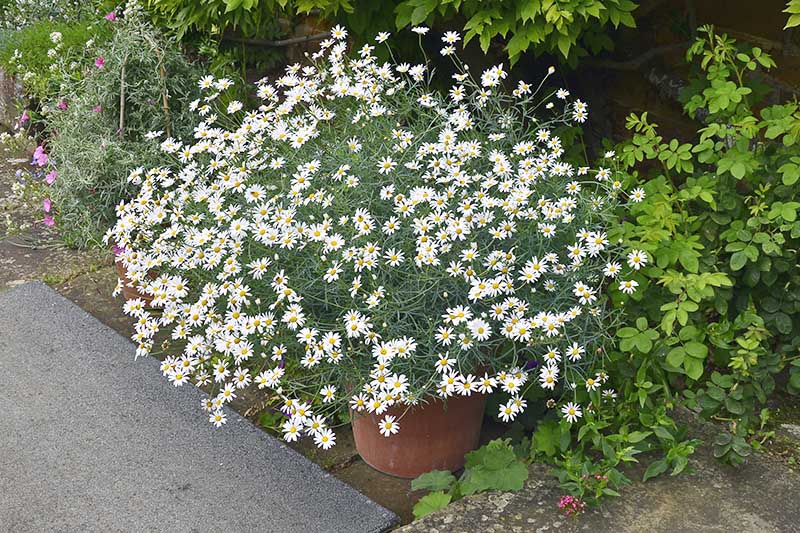
I’m not going to lie, I even kept a few chamomile plants in tiny six-inch containers on my windowsill when I lived in an apartment.
Don’t judge me for crowding the poor plants. Something about the little pots added a joyful element to my home, even though I didn’t get much of a harvest.
If you decide to grow chamomile in your container garden, please let us know how it goes! I look forward to hearing from you in the comments below.
And if you decide to expand your collection of container-grown plants, check out these guides next:
- How to Grow Zucchini in Containers
- How to Grow Rhubarb in Containers
- How to Grow Chives in Containers
© Ask the Experts, LLC. ALL RIGHTS RESERVED. See our TOS for more details. Product photos via Eden Brothers. Uncredited photos: Shutterstock. With additional writing and editing by Clare Groom and Allison Sidhu.
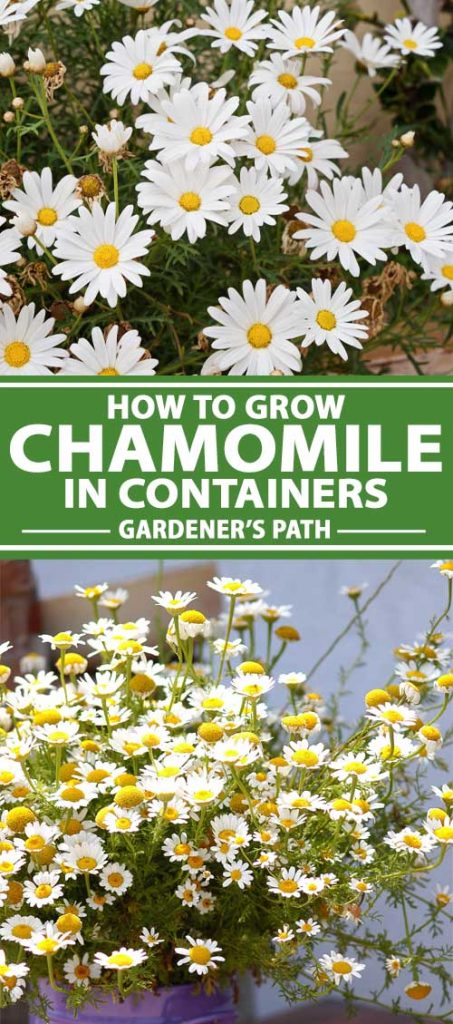

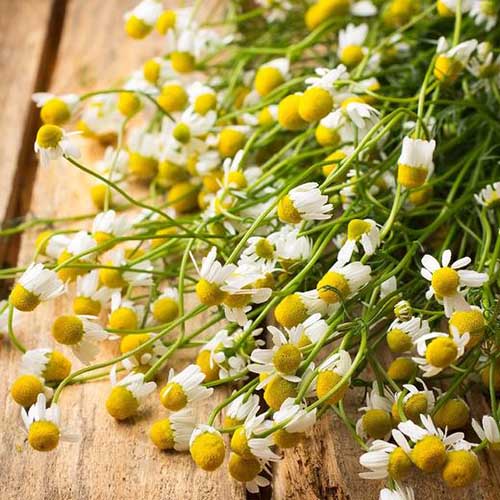
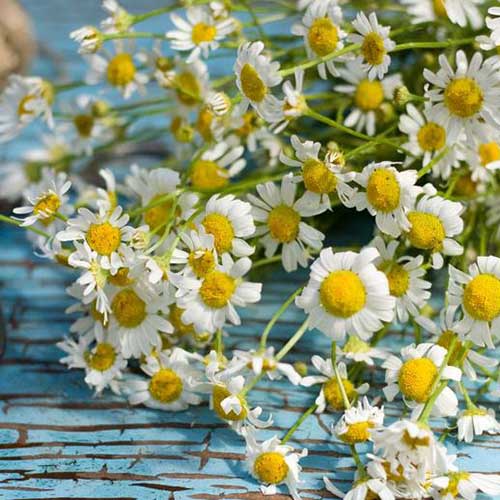

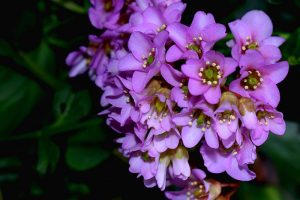

I love chamomile thanks for the information
A quick question! If you were planting in a planter with either basil or mint, would you 50/50 the pot, or put one in the middle and the others circling round it?
TIA 🙂
You can’t go wrong, the three grow well together, but I would put in a little more chamomile than mint, since mint can be pushy. I usually put mint towards the outside of my containers and train it over the sides in a weeping habit.
Thanks!
Want these flowers to plant for business